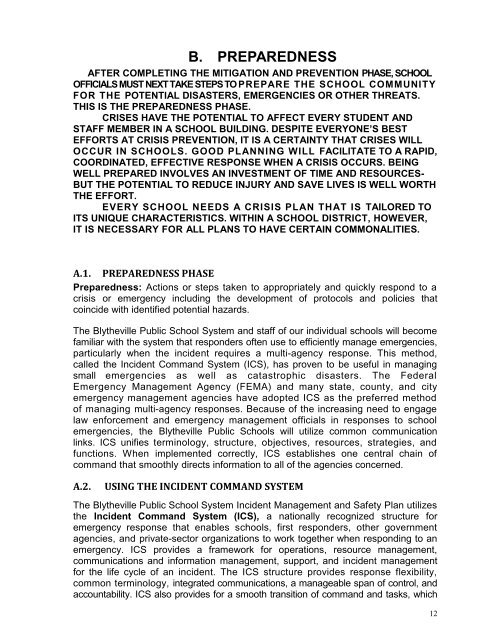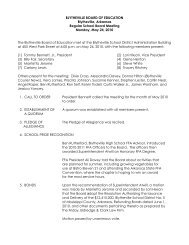District-Wide Safe Schools and Crisis Plan - Blytheville Public Schools
District-Wide Safe Schools and Crisis Plan - Blytheville Public Schools
District-Wide Safe Schools and Crisis Plan - Blytheville Public Schools
You also want an ePaper? Increase the reach of your titles
YUMPU automatically turns print PDFs into web optimized ePapers that Google loves.
B. PREPAREDNESS<br />
AFTER COMPLETING THE MITIGATION AND PREVENTION PHASE, SCHOOL<br />
OFFICIALS MUST NEXT TAKE STEPS TO PREPARE THE SCHOOL COMMUNITY<br />
FOR THE POTENTIAL DISASTERS, EMERGENCIES OR OTHER THREATS.<br />
THIS IS THE PREPAREDNESS PHASE.<br />
CRISES HAVE THE POTENTIAL TO AFFECT EVERY STUDENT AND<br />
STAFF MEMBER IN A SCHOOL BUILDING. DESPITE EVERYONE’S BEST<br />
EFFORTS AT CRISIS PREVENTION, IT IS A CERTAINTY THAT CRISES WILL<br />
OCCUR IN SCHOOLS. GOOD PLANNING WILL FACILITATE TO A RAPID,<br />
COORDINATED, EFFECTIVE RESPONSE WHEN A CRISIS OCCURS. BEING<br />
WELL PREPARED INVOLVES AN INVESTMENT OF TIME AND RESOURCES-<br />
BUT THE POTENTIAL TO REDUCE INJURY AND SAVE LIVES IS WELL WORTH<br />
THE EFFORT.<br />
EVERY SCHOOL NEEDS A CRISIS PLAN THAT IS TAILORED TO<br />
ITS UNIQUE CHARACTERISTICS. WITHIN A SCHOOL DISTRICT, HOWEVER,<br />
IT IS NECESSARY FOR ALL PLANS TO HAVE CERTAIN COMMONALITIES.<br />
A.1. PREPAREDNESS PHASE<br />
Preparedness: Actions or steps taken to appropriately <strong>and</strong> quickly respond to a<br />
crisis or emergency including the development of protocols <strong>and</strong> policies that<br />
coincide with identified potential hazards.<br />
The <strong>Blytheville</strong> <strong>Public</strong> School System <strong>and</strong> staff of our individual schools will become<br />
familiar with the system that responders often use to efficiently manage emergencies,<br />
particularly when the incident requires a multi-agency response. This method,<br />
called the Incident Comm<strong>and</strong> System (ICS), has proven to be useful in managing<br />
small emergencies as well as catastrophic disasters. The Federal<br />
Emergency Management Agency (FEMA) <strong>and</strong> many state, county, <strong>and</strong> city<br />
emergency management agencies have adopted ICS as the preferred method<br />
of managing multi-agency responses. Because of the increasing need to engage<br />
law enforcement <strong>and</strong> emergency management officials in responses to school<br />
emergencies, the <strong>Blytheville</strong> <strong>Public</strong> <strong>Schools</strong> will utilize common communication<br />
links. ICS unifies terminology, structure, objectives, resources, strategies, <strong>and</strong><br />
functions. When implemented correctly, ICS establishes one central chain of<br />
comm<strong>and</strong> that smoothly directs information to all of the agencies concerned.<br />
A.2. USING THE INCIDENT COMMAND SYSTEM<br />
The <strong>Blytheville</strong> <strong>Public</strong> School System Incident Management <strong>and</strong> <strong>Safe</strong>ty <strong>Plan</strong> utilizes<br />
the Incident Comm<strong>and</strong> System (ICS), a nationally recognized structure for<br />
emergency response that enables schools, first responders, other government<br />
agencies, <strong>and</strong> private-sector organizations to work together when responding to an<br />
emergency. ICS provides a framework for operations, resource management,<br />
communications <strong>and</strong> information management, support, <strong>and</strong> incident management<br />
for the life cycle of an incident. The ICS structure provides response flexibility,<br />
common terminology, integrated communications, a manageable span of control, <strong>and</strong><br />
accountability. ICS also provides for a smooth transition of comm<strong>and</strong> <strong>and</strong> tasks, which<br />
12
















